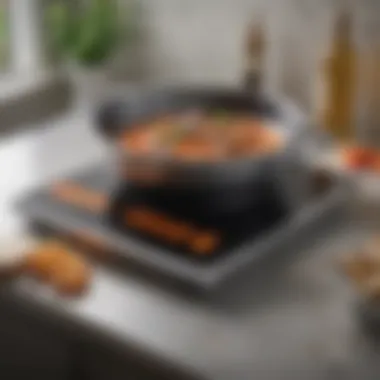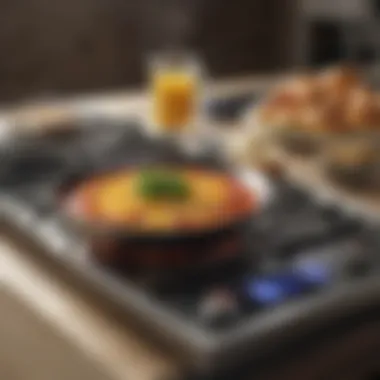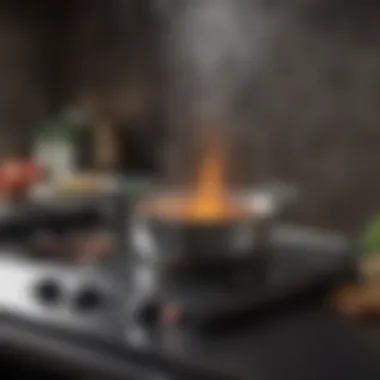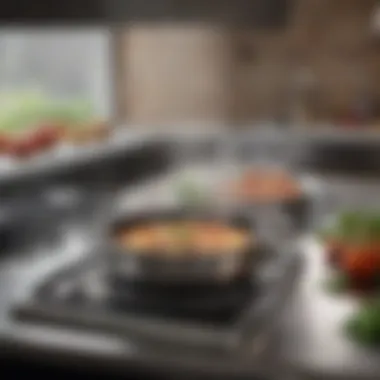Induction Cooking: Why It's Better Than Gas


Intro
Induction cooking represents a significant shift in culinary technique, gaining traction as a viable alternative to traditional gas cooking. This method employs electromagnetic energy to directly heat cookware, unlike gas, which relies on an open flame. Such a transition is not merely a matter of preference; it reflects a broader trend towards efficiency, safety, and environmental responsibility in the kitchen.
In this article, we will dissect the advantages that induction cooking offers over gas methods. We'll delve into ease of use, temperature control, and the safety features that make it a favorite among modern chefs. Additionally, we explore the environmental implications, examining how this method contributes to reduced carbon emissions and energy consumption. Economic considerations will also come under scrutiny, as we assess the long-term savings associated with using induction cooking. By synthesizing these elements, we lay out a compelling case for why transitioning to induction may be the right choice for many households today.
Prelims to Cooking Technologies
Cooking technologies have transformed how we prepare our food. The method of cooking influences not only the taste and texture of our meals but also energy consumption and kitchen safety. Understanding these technologies is essential for making informed decisions about home equipment and practices. This article focuses specifically on induction cooking technologies as a superior alternative to gas cooking systems.
By exploring the practical benefits of induction in terms of efficiency, environmental impact, safety features, and economic considerations, readers can appreciate the significance of these advancements in modern kitchens. With rising energy costs and growing awareness of environmental issues, the selection of a cooking technology becomes more than just a choice of preference; it reflects broader social and economic trends.
Overview of Cooking Methods
In the culinary landscape, various cooking methods exist, each bringing distinct advantages and challenges. Traditional cooking methods like gas, electric, and induction each utilize different principles of heat transfer. Gas stoves, for example, generate heat through open flames, which directly heat cookware placed on the burner. Meanwhile, electric stoves rely on coil or smooth-top heating elements that transfer heat through conduction.
Induction cooking, however, distinguishes itself through its unique approach. It uses electromagnetic fields to directly heat compatible cookware, offering faster cooking times and enhanced energy efficiency. This method has garnered attention for its precise temperature control, making it increasingly favored among culinary professionals and home chefs alike.
Defining Induction and Gas Cooking
Induction cooking uses magnetic fields to create heat directly within the pot or pan. This means that the cooktop surface remains relatively cool, which minimizes the risk of burns or kitchen fires. It also tends to cook food faster because the heat is not wasted. To utilize induction cooking, specific cookware made from ferrous materials is required. Stainless steel and cast iron are often good choices.
In contrast, gas cooking involves a direct flame to provide heat. While gas stoves can offer high heat output and visual feedback for temperature control, they also come with risks. The open flame presents a fire hazard and can release harmful gases. Moreover, energy efficiency tends to be lower when compared to induction cooking, making it less favorable in terms of operational costs. The comparison between these two methods lays the groundwork for understanding why many consider induction cooking a superior option.
Efficiency of Induction Cooking
The efficiency of induction cooking stands out as a significant factor in the discussion of modern cooking technologies. This method utilizes electromagnetic energy, offering remarkable speed and precision in culinary processes. The benefits of induction cooking extend beyond mere convenience, making it an attractive option for the environmentally conscious and economically minded.
Energy Consumption Patterns
Induction cooking exhibits superior energy consumption patterns compared to gas cooking. In gas cooking, a significant portion of heat is lost to the surrounding environment. This is not the case with induction methods. According to studies, induction cooktops convert about 90% of the energy used into actual heat for cooking. In contrast, gas cooktops typically convert only around 40-55% of their energy.
This translates to effective use of energy, which can lead to reduced utility bills over time. Furthermore, as households increasingly prioritize sustainability, the focus on energy-efficient cooking technologies becomes paramount. The transition to induction cooking can result not only in immediate savings but also contribute to long-term environmental benefits by reducing overall energy demand.
Heat Distribution and Control
One of the standout features of induction cooking is its heat distribution and control. When using an induction cooktop, heat is generated directly within the cookware. This mechanism ensures that heat is delivered uniformly and efficiently across the surface of the cooking vessel. Consequently, one achieves optimal cooking results, whether sautéing vegetables or simmering sauces.
Control over the temperature settings is also more precise in induction cooking. Users can switch from high heat to a gentle simmer almost instantaneously. This level of control minimizes the risk of burning food, a common issue faced with traditional gas methods. It further supports culinary techniques that require close monitoring, enhancing the cooking experience for both amateur cooks and seasoned chefs alike.
"Induction cooking allows for immediate adjustments in heat settings, providing a level of precision not easily achieved with gas."
In summary, the efficiency of induction cooking is marked by its low energy consumption patterns and superior heat distribution capabilities. These characteristics not only enhance the practical aspects of cooking but also align with broader trends advocating for sustainable energy use.
Safety Considerations
Understanding the safety aspects of induction cooking is essential for anyone considering shifting from gas. With the growing emphasis on safety in kitchens, induction cooking offers several pivotal benefits. Two main areas of concern are the flame risk associated with gas cooking and the burn risk that can occur in busy kitchen environments.
Flame Risk and Kitchen Safety
Gas cooking presents a clear risk due to open flames. This element can lead to unintentional fires if flammable materials are too close or if there is a gas leak. Induction cooking, however, eliminates open flames entirely. Instead of producing heat through combustion, induction uses electromagnetic fields to heat cookware directly. This method reduces the chance of kitchen fires significantly.
In addition, there are safety features in modern induction cooktops that contribute to a safer cooking environment. Features such as automatic shut-off, induction detection for incompatible cookware, and even child safety locks make using these systems much safer. They allow users to focus on cooking without constantly fearing accidents involving flames.


Burn Risk Evaluation
Burn injuries are common in kitchens and can occur for various reasons. In gas cooking, the hot surfaces around the flames present a constant risk, as do the pots and pans after cooking, which remain hot for some time. Induction cooking mitigates this risk due to its unique heating mechanism; the cooktop itself stays comparatively cooler since it does not become hot unless a magnetic cookware is placed on it.
Research shows that induction cooktops, when used properly, reduce the likelihood of burns by up to 90% compared to traditional gas stoves.
However, it is important to remember that while the cooktop stays cooler, the cookware can still reach high temperatures. A cautious approach is needed when handling pans after cooking. Users should always make sure to use appropriate oven mitts and utensils to avoid burns, regardless of the cooking method.
In summary, understanding safety in the kitchen requires examining the unique risks of different cooking methods. Induction cooking, while not exempt from potential hazards, installs many safety features and fundamentally changes the cooktop's design to promote a safer cooking environment.
Environmental Impact
Understanding the environmental impact of cooking technologies is increasingly essential as society confronts climate change and resource depletion. This section explores how induction cooking offers a more environmentally friendly alternative compared to traditional gas cooking methods. With a focus on specific elements such as carbon emissions and resource sustainability, we will clarify the benefits of adopting induction cooking in a modern kitchen.
Carbon Emissions and Energy Sources
The shift towards induction cooking influences carbon emissions significantly. Induction cooktops utilize electricity to generate heat directly in compatible cookware, resulting in reduced energy waste. In contrast, gas cooking relies on fossil fuels, which generate carbon dioxide during combustion. This extra carbon footprint contributed by gas is a critical issue for the environment.
Additionally, the source of electricity used in induction cooking plays a crucial role in its overall environmental impact. When powered by renewable energy, such as wind or solar, induction cooking becomes a virtually carbon-neutral choice.
"Switching to induction can cut household carbon emissions by a considerable percentage if combined with a clean energy source."
This means the effectiveness of induction cooking varies based on the energy grid of a region. Some areas may utilize cleaner energy than others, so assessing local energy sources is essential for potential users.
Sustainability of Resources
Another advantage of induction cooking relates to the sustainability of resources it promotes. Induction generally requires less energy compared to gas, leading to more efficient resource utilization. Less energy consumption directly translates to fewer natural resources used over time--a vital point in today's context of limited fossil fuel reserves.
Moreover, with induction cooking, usability extends to a broad range of cooking capacities and cookware. Users can select from various materials that often last longer and perform better regarding energy efficiency.
Some of the key aspects are:
- Longer-lasting Cookware: Induction-compatible cookware is often more robust, leading to reduced waste over time.
- Lower Energy Requirements: Efficient energy use means less absolute electricity is needed for cooking.
Cost-Effectiveness Analysis
Understanding the cost-effectiveness of induction cooking is crucial. This analysis allows consumers to weigh initial expenses against long-term savings. The shift toward induction from gas is not just about technology; it encompasses a financial aspect as well. Homeowners are increasingly mindful of how their cooking methods affect their budgets and the overall value of their kitchen investments. With this focus on money, evaluating both upfront and continuous costs associated with induction cooking provides a clear perspective on its appeal.
Initial Investment and Installation Costs
When considering induction cooking, the initial investment can be higher compared to traditional gas appliances. An average induction cooktop often ranges from $300 to $1,500, depending on the features and brand. Installation costs may also add up. It's essential to account for proper electrical wiring, which sometimes requires updating the existing kitchen setup.
Additional considerations include:
- Cookware: Induction cooking requires specific magnetic-compatible cookware. Replacing or investing in these items can add to overall costs.
- Professional Installation: Hiring a skilled electrician might be necessary to ensure safety and compliance with local regulations.
Despite a higher starting price, many consumers find the investment reasonable when factoring in the efficiencies gained. It is essential to do proper calculations before making a purchase. Understanding the total cost of ownership is vital for making an informed decision.
Long-Term Savings and Efficiency
One of the standout benefits of induction cooking is efficiency. Induction cooktops use electromagnetic energy, which directly heats the cookware, resulting in food cooking faster and using less electricity compared to gas. Over time, these efficiencies translate into significant savings on energy bills.
Consider these points regarding long-term savings:
- Energy Consumption: Induction cooktops can boil water about 50% faster than gas, leading to shorter cooking times.
- Reduced Energy Bills: The direct heat method minimizes wasted energy. In the long run, homes can see reductions in utility costs.
- Lower Maintenance Costs: Induction surfaces are easier to clean. This factor can lead to lower maintenance expenses over time.


"Induction cooking is not only about modern cooking; it's also about economic intelligence."
In summary, the cost-effectiveness of induction cooking involves analyzing both initial investments and potential long-term savings. As technology continues to progress, these factors will likely shape consumer choices in the years to come.
Culinary Versatility
Culinary versatility is a key advantage of induction cooking that warrants careful consideration. This cooking method not only accommodates a variety of cooking styles but also largely enhances the overall experience for home cooks and professional chefs alike.
The induction cooking system’s responsive heat control allows for precise adjustments. This precision is beneficial for complex cooking techniques that require strict temperature management. When transitioning from simmering to boiling, users will notice a quick response time. This is vital for dishes such as sauces, custards, or delicate proteins that can easily overcook.
Moreover, the flexibility of induction cooking extends to the types of culinary techniques that can be applied. Whether you are searing a steak, simmering a sauce, or melting chocolate, induction offers an advantageous platform for various methods.
Types of Cookware Compatible with Induction
Not all cookware is suitable for induction cooking, but the types that are tend to maximize functionality. For induction cooking, cookware must be ferrous, meaning it needs to be made from magnetic materials. Common compatible materials include:
- Stainless steel: Known for its durability and non-reactive properties, high-quality stainless steel is effective for induction cooking.
- Cast iron: Excellent heat retention makes cast iron ideal for many cooking techniques.
- Enameled cast iron: Combines the benefits of traditional cast iron with the ease of cleaning.
- Magnetic cookware: Specifically designed for induction, often marked by a symbol for easy identification.
On the contrary, cookware made from glass, aluminum, or copper without a magnetic base will not work on induction stovetops. This limitation sometimes leads to misconceptions about the method, since many assume that all types of cookware can readily function with induction technology. Understanding these specifications, therefore, is crucial.
Cooking Techniques Specific to Induction
Induction cooking supports several cooking techniques, improving not just efficiency but also the final results. Here are some noteworthy techniques that are particularly enhanced by this technology:
- Searing: The precision of heat allows for effective searing of meats, creating a tasty crust without losing moisture within.
- Boiling: Water heats up faster than with gas or electric cookers, which can bring pots of water to a boil in record time.
- Simmering: The fine control over heat settings helps maintain a consistent simmer, essential for soups and stocks.
- Frying: Temperature control is crucial; induction makes maintaining the correct oil temperature easier, leading to less greasy outcomes.
User Preferences
Understanding user preferences when it comes to cooking technologies is crucial for any analysis of induction cooking versus gas. Preferences shape purchasing decisions and directly reflect what consumers value most in their kitchen experiences. This section examines the various aspects that influence these choices, focusing on benefits, considerations, and implications for both novice cooks and professional chefs.
Consumer Trends in Kitchen Appliances
Consumer trends indicating a shift towards induction cooking reveal a deeper understanding of modern kitchen needs. Many buyers now prioritize energy efficiency and safety in their kitchen appliances. As cooking styles evolve, more people seek technologies that accommodate their fast-paced lives while ensuring ease of use.
- Energy Efficiency: A significant number of consumers favor induction cooking because of its ability to reduce energy consumption.
- Safety Features: Induction cooktops are often perceived as safer compared to gas due to the absence of flames.
- Convenience: The speed at which induction heats and uses cookware encourages new cooks and seasoned chefs alike to opt for this method.
According to a survey conducted in recent years, about 65% of homeowners expressed a preference for smart kitchen appliances, including induction cooktops. This trend showcases a shift towards incorporating technology that can optimize cooking efficiency, contributing to a more streamlined kitchen environment.
Feedback From Professional Chefs
Professional chefs play a pivotal role in influencing cooking technology trends. Many culinary experts praise induction cooking for its precision and control, allowing for more refined cooking methods. Here are some notable observations provided by chefs who have integrated induction cooking into their kitchens:
"Induction allows me to focus on the timing and technique rather than worrying about fluctuating heat levels. It’s a game changer for plate finesse and consistency."
- Precision Heating: The ability to control temperature accurately is often highlighted as a critical factor for chefs seeking to elevate their dishes.
- Speed and Efficiency: Chefs note that induction cooking significantly reduces preparation time, which is essential in a fast-paced restaurant environment.
- Cleanliness: The ease of cleaning induction surfaces is valued since quick wipe-downs between meal preparations enhance hygiene in professional kitchens.
Challenges of Induction Cooking
Induction cooking, while offering many benefits over traditional gas methods, is not without its challenges. Understanding these challenges is crucial for both potential adopters and current users of induction technology. It provides a realistic perspective on what one can expect when transitioning to or utilizing induction cooking. Addressing these challenges can lead to better cooking experiences and may dispel the doubts some may have about this technology.
Limitations in Cookware Selection
One significant challenge with induction cooking stems from the requirements of compatible cookware. Induction cooktops create heat through electromagnetic energy, which means they can only work with ferrous materials. Cookware made from materials like stainless steel and cast iron is appropriate, but aluminum, glass, and copper alone are not suitable unless they have a magnetic base.


Purchasing new cookware can be an expense that some users are not prepared for. Many might be unfamiliar with the necessary characteristics of induction-compatible cookware.
- Key points to consider:
- Look for markings indicating induction compatibility.
- Testing cookware with a magnet can help determine suitability.
- Brands may offer various options that fit induction models.
Understanding these limitations helps consumers make informed decisions on their purchases. An increased awareness can save money and ensure that the right cookware is chosen.
Common User Misconceptions
There are several misconceptions that surround induction cooking. Some users believe that induction is inherently more dangerous than gas cooking. This thought often arises from unfamiliarity with the technology rather than actual risk.
"Induction cooking is safe, and it doesn’t produce open flames, which significantly reduces kitchen hazards."
Another misconception is that induction cooking is slower than other methods. On the contrary, induction has been shown to heat more quickly than gas or electric options, providing superior control over the cooking process.
Here are common misconceptions that should be addressed:
- Safety Concerns: Induction cooktops are considered safer due to the lack of open flames.
- Speed and Efficiency: Many believe induction is slower; however, it heats food faster.
- Cost: Some think induction is too expensive, but prices continue to become more affordable in recent years.
- Energy Use: A common misbelief is that induction uses more energy; in reality, it is often more efficient than gas.
Understanding these misconceptions is vital for potential users. Correcting these misunderstandings can pave the way for a smoother adoption of induction cooking technology. Knowledge is key to adapting to modern cooking methods effectively.
Technological Innovations in Induction Cooking
The journey of induction cooking has been significantly shaped by technological advancements. These innovations enhance both the functionality and the appeal of induction cooktops. Understanding these developments not only enlightens consumers but also establishes induction cooking as a leader in culinary technology. The rise of innovative features offers exciting prospects that make cooking efficient and enjoyable.
Smart Induction Cooktops
Smart induction cooktops epitomize the intersection of cooking and technology. These devices utilize connectivity features, enabling them to link with smartphones and other smart devices. Users can remotely control cooking processes, adjusting temperature and monitoring cooking times while multitasking in other rooms. This ability to interact with cooktops through applications offers a new level of convenience.
Beyond remote control, smart induction cooktops may include automated settings that adjust heat levels based on the type of cookware used or the cooking method selected. Such features optimize cooking performance, ensuring better culinary results. Moreover, this technology often incorporates safety mechanisms, such as automatic shut-off if the pan is removed or overheating is detected.
Another key advantage is the integration of diagnostic tools. These can alert users to issues with the cooktop, allowing timely maintenance and increasing longevity. As consumers lean towards smarter choices in their kitchens, these innovations hold substantial relevance.
Integration with Smart Home Systems
The integration of induction cooking technologies with broader smart home systems represents a considerable leap forward in home automation. Linking induction cooktops with home assistants can create an orchestrated cooking environment. For example, a user can set a meal timer, which can alert them when to check on dishes or even adjust stove settings based on pre-set recipes.
This level of integration allows for voice-activated commands. Users can adjust their cooktop hands-free, facilitating a seamless cooking experience. All of this contributes to a more efficient kitchen workflow, enabling individuals to focus on creativity rather than just temperature control.
Looking Ahead
As the demand for smart home technology grows, so does the potential for even more innovative features in induction cooking. The convergence of cooking technology with home automation presents exciting possibilities that can streamline culinary processes. Such advancements not only enhance user experience but also pave the way for future trends in cooking methods.
"The evolution of induction cooktops is not just about improving efficiency; it's about reimagining the entire cooking experience to fit modern lifestyles."
End: The Case for Induction Cooking
Induction cooking presents itself as a prominent alternative to gas cooking. The decision to favor induction methods carries several unique advantages that can significantly impact daily culinary experiences. Understanding these benefits is essential for consumers who seek efficiency, safety, and sustainability in their kitchen practices.
Summary of Key Findings
In this article, we explored various aspects that highlight induction cooking’s superiority over gas.
- Efficiency: Induction cooking has been found to utilize energy more effectively. Unlike gas, which often loses heat during the cooking process, induction directly transfers energy to the cookware. This results in reduced cooking times and lower energy bills.
- Safety: The absence of an open flame in induction cooking lowers the risk of kitchen fires. Moreover, the cooktop surface cools quickly after removing pans, minimizing the chances of burns.
- Environmental Impact: With growing concerns regarding climate change, the lower carbon footprint associated with induction cooking makes it an attractive choice. It contributes to reduced greenhouse gas emissions over time when powered by renewable electricity sources.
- Cost-Effectiveness: While the initial investment in induction appliances can be higher, the long-term savings from reduced energy costs and increased durability of induction cookware justify this expense. Consumers can appreciate this advantage over the years.
- User Preferences: Recent trends indicate a growing acceptance of induction technology among home cooks and professional chefs alike. User feedback reveals a preference for precise control over cooking temperatures, improving overall cooking outcomes.
Future Trends in Cooking Technologies
The landscape of cooking technologies continues to evolve, showcasing promising advancements in induction cooking. Here are some trends to watch:
- Integration with Smart Home Technology: As smart home systems gain popularity, induction cooktops are becoming part of this ecosystem. Features like remote monitoring, automated cooking settings, and energy usage tracking are becoming common.
- Enhanced Culinary Features: Modern induction cooktops are now equipped with features that allow for precise temperature settings and smart controls. This aids in achieving professional-level culinary results at home.
- Advancements in Cookware: The availability of a wider range of induction-compatible cookware is increasing. Manufacturers are innovating materials that optimize induction heating, catering to the diverse cooking styles of culinary enthusiasts.
"The transition to induction cooking reflects not just a shift in technology, but a significant cultural transformation towards safer and more efficient cooking practices."







